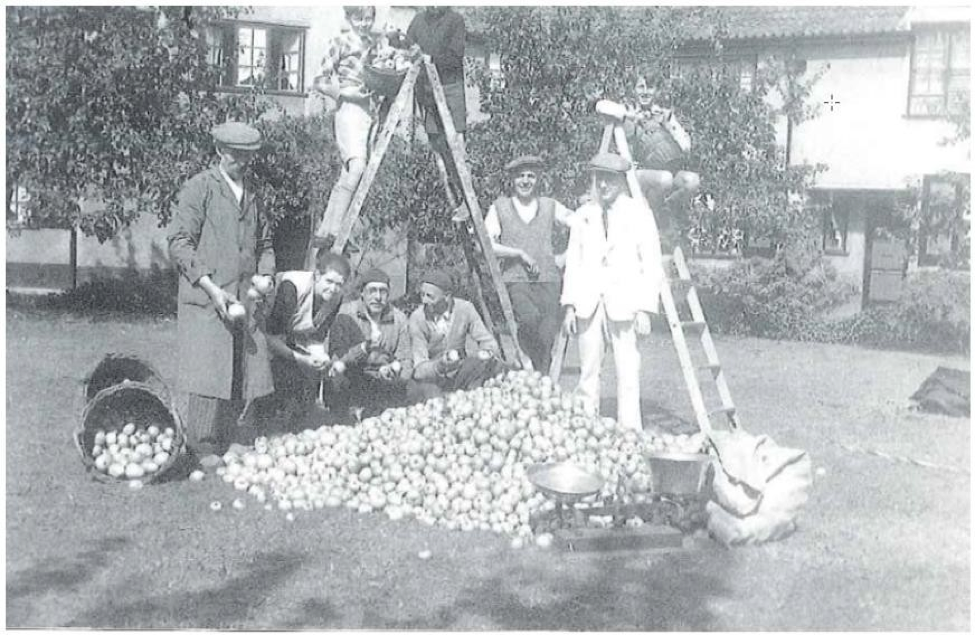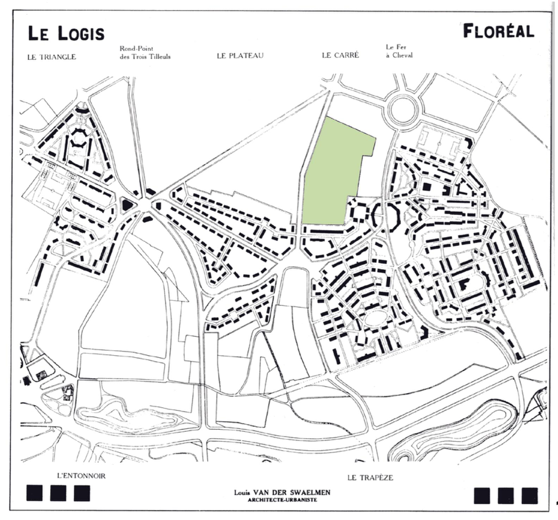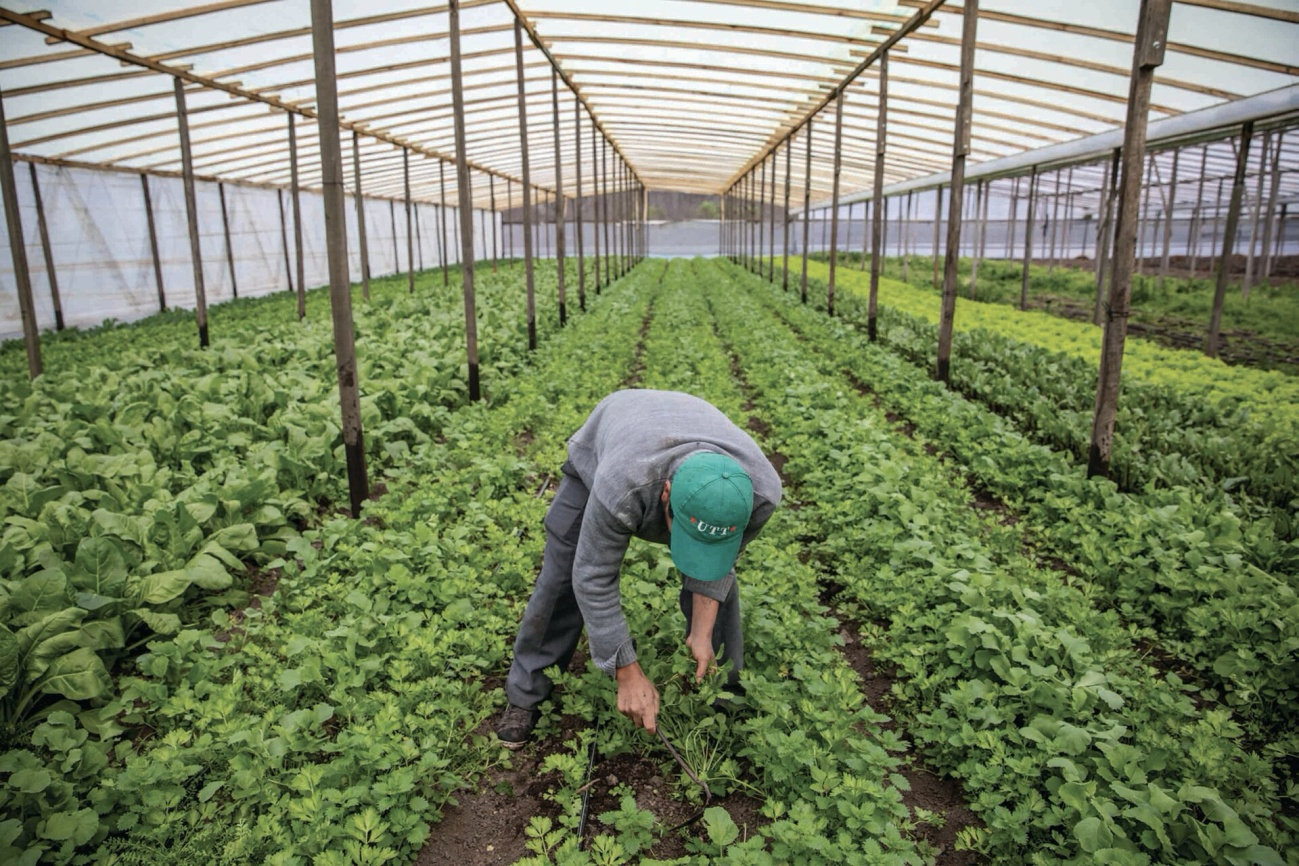The Productive Housing Estate looks at complementary relationships between housing and food growing spaces. It tries to overcome the latent conflict between the capacity to exercise the right to grow and the right to shelter within an urbanised context. Not only is greenfield development consuming farm land. Also, the other way around living in close proximity to spaces for growing food is discouraged by well-intended measures to protect farming land from urban speculation. The Productive Housing Estate seeks to plant principles of agroecology in people's daily lives in close proximity to where people spend their time, where people live, eat, study and work. The Productive Housing Estate incorporates food growing spaces as an integral part of the urban development dynamics through which the city is produced. The Productive Housing Estate seeks to interrupt the logics of substitution that facilitate a (speculative) land use cascade that substitutes farmland for industry, industry for housing, housing for offices etc. In this way, the Productive Housing Estate seeks the partial decommodification of urban land use.
We see three moments that are key in bringing about the Productive Housing Estate respectively involving urban development coalitions, farmers and growers in search for combined growing and living spaces, and producer-consumer coalitions:
The Productive Housing Estate may come about at the moment of development of a new housing estate, making the deliberate effort to proactively reserve space for food production within the boundaries of that development.
The Productive Housing Estate could be incorporated in the needed effort to protect agricultural land, however creatively accommodating the possibility for agroecological growers to live in close proximity to their productive lands.
The Productive Housing Estate may be shaped through the joint efforts of overlapping grassroot networks between growing and housing communities, whether it is an urban campus, compound or estate inviting in the growers, or a growers space establishing a privileged relationship with neighbouring urban communities.
Why a Productive Housing Estate?
Organised (dis)connection between growing and living
Under conditions of urbanisation the right to grow and the right to shelter have become part of separate spheres of discussion. Urban dwellers are largely cut off from structural possibilities to grow. (Tornaghi 2017) And even within contemporary debates on sustainable food planning the dominant adopted position is one that simply accepts that the urban side of the food question can be limited to the question of consumption and the connection of consumers and producers across the urban rural divide. (Deh-Tor 2021) Urban Agriculture seems to be the exception to this rule, but still tends to accept the urban morphology, and the ways in which urban spaces are structured and planned. Food planning still leaves the current situation in which urbanisation comes at the expense of space for food production, leads to the further destruction of soils and to the loss of food growing skills in the urban population.
Dynamics of urbanisation also lead to difficulties in access to housing for farmers. Public investment in land readjustment and infrastructure has been mainly geared at facilitating the scaling up of farming and the introduction of mono-crop, industrial agriculture, with little to no regard for housing the land worker. The peri-urban belt in many cities has been protected against sprawl, but as such has made it difficult or unaffordable for growers to live close to the lands they cultivate. Agricultural land is often little more than a land use category. Not only is agricultural land not used as such, even when cultivated its use is increasingly disconnected from precise ideas regarding a balanced agricultural geography, rooted in a deep understanding of the landscape and stewardship over natural resources.
For most agroecological growers the possibility to live on the land is essential. Agroecology is a labour intensive farming model that is based in the care for the soil but also in the permanent interaction with localised, ecological processes requiring presence, attention and response. The possibility to live on the land is also key to their economic survival and is part and parcel of their capacity to reinforce their independence from external inputs (van der Ploeg 2008).
Integration of the right to grow in urban planning is not new
“There you will see in profusion the sheds and shacks, the pigeon lofts and the makeshift greenhouses, the lean-to shelters and the children’s huts - all by som blessed oversight escaped from planning control, all standing as reminders of needs which contemporary housing policies have failed to meet.”
Colin Buchanan, ‘why every man must have a shed’, The Countryman, Vol.80.No.2, summer 1975. As quoted in David Crouch and Colin Ward, The Allotment, 1988, p.11.
While urbanisation tends to replace agriculture by other types of land use, there are several historical examples that tried to imagine forms of urbanisation in which urban development and food production would go hand in hand. Food growing spaces and housing are historically closely linked. Food and shelter define two essential aspects of the social reproduction of (urban) lives. Capitalist modalities of urbanisation have contributed to the separation of food production and housing, naturalising a state in which food is produced elsewhere and provided in the urban context in commodified form. (Steel 2008) Many historical housing reform initiatives include a food production element and have tried to link the decommodification of housing to the decommodification of food and the land needed for both. The garden city movement was not only a housing reform movement but tried to put the control over primary and industrial production in the hands of a garden city corporation. (Parham 2021, Imbert 2015) The anarchistic revolutionaries such as Peter Kropotkin imagined inhabited landscapes of fields, factories and workshops in which housing, industry, would not be sorted into separate worlds, but cultivated in close proximity and mutual solidarity (Ward 1999). There is a rich tradition of allotment gardening, including nationwide legislation in the UK for example requiring municipalities to give access to citizens to be able to auto-produce, incorporating the right to grow into our town and cities means also to start revaluing those traditions and protect the spaces for local communities to grow (Crouch and Ward 1988). In the Eastern European context growing food in allotment gardens was reintroduced during Soviet rule, when due to food shortages the state provided inhabitants of large housing estates with sizable allotment complexes, some of which exist until today. In the post socialist period such traditions have been able to thrive as a form of ‘quiet sustainability’ (Smith & Jehlička 2013), a setting in which people grow for themselves, without being part of strongly articulated and politicised growers’ movement. However, these groups and individuals do continue to rely on social networks in which skills are shared, reproduced and passed on through the generations. We could also make reference to specific socialist models that included housing models as part of specific agrarian reform movements, as was the case in the Israeli Kibbutzim and Moshavim.

Cueillette des Pommes à la cité‐jardin – Le Logis-Floréal À Watermael-Boitsfort, 1940
The Ferme du Chant des Cailles is a collective urban agricultural project initiated by farmers together with local citizens in a residential neighbourhood in Watermael-Boisfort, in the south-east of Brussels. The land on which the farm was established lies in the heart of the Logis Floréal, a garden suburb developed in the 1920’s designed by Louis Vanderswaelmen. The land was reserved in the original plan for a farm that was never built, but the settlement included individual productive gardens, productive fruit trees in the public domain and an orchard. The pressing need for new social housing in Brussels led the authorities to consider the land historically reserved as a productive space for the construction of 250 additional housing units, especially since the social housing company was owner of the land. However, the mobilisation of local citizens put the process of the development project on hold. The coalition of citizens even mapped vacancies in the neighbourhood, questioning the need for new development. What started with the idea of repurposing an abandoned field developed into a process of reappropriation of a historical urban pattern, relinking housing and food production, underlining the need for new planning tools and processes that consider community-build food production as equally valuable on the urban agenda as housing, schools or playgrounds.

Historical plan of Louis Vanderswaelmen with the historical productive land that today hosts the Fermes du Chants des Cailles highlighted
What change is needed?
The Productive Estate seeks to reinforce the possibility to work across the strong separation between public and private spheres that cuts off individuals from possibilities to exercise their right to grow. By working across that divide, this building block imagines new settings in which the reproduction of skills and resources may be planted within a context of personal development and voluntary engagement.The Productive Housing Estate seeks to enable:
The right to grow. The care for the availability and access to growing soils is a structural responsibility of an urban community and requires the needed solidarity with growers and the necessary support to exercise the right to grow.
The right to shelter. The right to live in close proximity to growing spaces is key to secure the sustainable livelihoods of agroecological growers.
Proximity and place-based solidarities. Proximity matters and is a powerful resource to foster mutual engagement between agroecological growers and housing communities both highly dependent on access to land. Seeing their mutual importance in the construction of urban livelihoods may help to build a more inclusive land agenda, including the preservation of growing spaces as part of urban development rather than playing one against the other.
Including the right to grow as part of the right to the city
The often highly privatised residential landscapes of urban and suburban expansion continue to harbour practices of growing by residents in their own backyard. These forms of ‘quiet sustainability’ rooted in everyday practices, are highly individual and personally motivated. (Sovova, L 2016) However, such little politicised attempts to keep or regain control over the means of social reproduction, whether it is in the form of self-growing or informal forms of food sharing, do contain the seeds upon which more politicised forms of sovereignty could be built. We find in these private spaces strong resistance or deep reluctance to move beyond relations of self-interest but also a lack capacity to self-organise and address problems that are structural in nature. This shows how much ideas about the proper place of food production are hardwired in our urban landscapes. The current way in which relationships between housing and food are articulated have to be questioned if we seek to imagine urban landscapes where the right to grow can be exercised as part of the right to the city, and seek to give a proper place to self provision in the building of resourceful urban communities.

The Land Justice Network is a coalition of grassroots actors in the UK that have started up a series of remarkable initiatives around a people-driven land reform, placing principles of the equitable sharing of land at the core. One of the notable things about the coalition of partners behind the Land Justice Network is that it not only includes groups mobilising around access to land for growers and land workers but also groups that are fighting for housing rights, and more generally groups focussing on decolonisation. The People's Land Policy is a shared mission statement referring to the People's Food Policy by the Land Workers Alliance. The strength of the coalition is the clear desire to fight the various struggles over land together. Where current capital-driven processes of urbanisation play various forms of land use against each other, using bidding rent and market competition as the determining factor in allocating land, the People’s Land Policy inspires us to imagine an agroecological urbanism where the use value of soils becomes a leading factor, and where the reproduction both of the right to live and to cultivate are secured together rather than in competition.
A mixed mosaic of growing and housing spaces
Solidarities between urban and growing spaces in many cities around the world continue to be reproduced through direct ties urban dwellers have to friends and family outside of the city. For many urban dwellers this relationship to the peri-urban and rural hinterland may include a secondary residence, or summer house, where urban dwellers may own land. The morphological mix off growing and housing spaces, while typical of the peri urban fringe, is usually not inhabited in ways that engender rich relations between farmers and urban communities, but the mixed geography of built and unbuilt spaces offers interesting possibilities to imagine the ecological re-edition of these landscapes, that could come in the reintroduction of agroecological farming models and housing models that respect, and even coproduce and rebuild the needed landscape infrastructure of this peopled landscape.

The Lucavsala Island is located in the Daugava River in Riga. This island of about 150 ha is for a large part covered with an allotment garden complex of over 600 plots. As of today many of these allotment gardens are no longer cultivated. Some plots are reclaimed by a new generation of urban gardeners, many are being used as weekend and vacation spaces, and others are illegally occupied as spaces of residence. The allotment complex is under pressure of development. The tip of the island has been remodelled as an urban park, and the land adjacent to the park rezoned for high rise residential and mixed use development. This has led to mobilisation among some of the remaining growers to imagine an alternative future. These large allotment complexes, still present in close proximity to the urban centre, are part of the food growing infrastructure of the city and are an asset that other cities have long lost.
The participative design research of Sampling as part of the Urbanising in Place project explored development strategies in which the allotment complex would be maintained and its productive function intensified. Participants to the exercise discussed the possibility of hosting professional growers side by side allotmenteers. The exercise also looked into the possibility of clustering houses for farmers rather than building on individual lots, which has generally led to the trading of the productive for residential use. Building on the rich legacy of allotmenteering of socialist urban development, these exercises seek to articulate the conflict between the right to access growing spaces and the right to housing in collective patterns of use and move beyond the particular and fragmented interest of the entitlement to a singular plot (for growing and living).
New farming colonies
In order to overcome the structural conflict between growing spaces and housing we may also begin to rethink settlement models that have predominantly the aspirations for sovereignty and autonomy in terms of ownership of land and the right to both cultivate the land and build on it. The fragility of this model is that such visions of autonomy include the right to alienate the land, including the right to speculate on future earnings that may be generated through other developments than farming. But more importantly, growers are struggling to gain access to land, let alone to become owners of the land. The Productive Housing Estate opens up this relationship between use and ownership, drawing on the rich tradition of agricultural leasing models, the obligations to keep the land in a good state, that were traditionally included in farming leaseholds, but also the rich geography of farming colonies established to house farming labour, also on a seasonal basis.

To be economically viable farmers need to be able to live close to the land and without additional housing costs. This concern is at the heart of the project Integral Agricultural Colony of Urban Supply (CAIAU) initiated in 2014 by the Unión de Trabajadores de la Tierra (UTT) after mobilisation by small producers. Each family has its house, works approximately 1 hectare of land and sells the produce in local markets (agroecological and non) and also organises box schemes for the inhabitants. The initiative of UTT also led the National Institute of Agricultural Technologies to work more seriously in family farming and agroecology. This argentinian initiative acknowledges the need to perceive agricultural land as part and parcel of a peopled landscape, in which the right to live on the land is part and parcel of a relationship of stewardship and not of land consumption.
See Las Colonias Agroecológicas (UTT) (Spanish)
Crouch, D., Ward, C. (1988) The Allotment. Its landscape and Culture. London & Boston: Faber and Faber.
Deh-Tor, C.M. (2021) ‘Food as an urban question, and the foundations of a reproductive agroecological urbanism’, in: Chiara Toranaghi & Michiel Dehaene (eds.) Resourcing and Agroecologica Urbanism. Political, Transformational and Territorial Dimensions. London: Routledge, pp. 12-33.
Parham, S. (2021). Food and the garden city. TERRITORIO. 53-62..
Imbert, D. (ed.) (2015) Food and the City. Histories of Culture and Cultivation. Washington D.C.: Dumbarton Oaks.
Smith, J & Jehlička, P. (2013). Quiet sustainability: Fertile lessons from Europe's productive gardeners. Journal of Rural Studies. 32. 148–157. 10.1016/j.jrurstud.2013.05.002.
Sovova, L. (2016) Self-provisioning, Sustainability and Environmental Consciousness in Brno Allotement Gardens, Sociální studia / Social Studies https://doi.org/10.5817/SOC2015-3-11
Steel (2008) Hungry City. How Food Shapes Our Lives. London: Random House.
Tornaghi, C. (2017) ‘Urban agriculture in the food-disabling city: (Re)defining urban food justice, reimagining a politics of empowerment’. Antipode, Vol. 49, No. 3, pp 781-801.
Van der Ploeg, J.D. (2008) The new peasantries: Struggles for autonomy and sustainability in an era of Empire and Globalization. London: Sterling, Earthscan.
Ward, C (1999) ‘A peopled landscape’. In: K. Walpole (ed.), Richer Futures: Fashioning a New Politics. London: Earthscan, pp. 83-98.